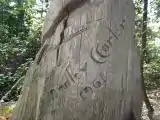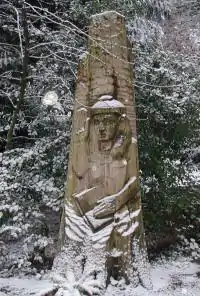Dudley C. Carter
Dudley Christopher Carter (May 6, 1891 – April 7, 1992) was an artist and woodcarver from the Pacific Northwest. His works are on display in the U.S. states of Washington, Oregon and California. There are also works of his on display in Japan and Germany.
Dudley C. Carter | |
|---|---|
| Born | Dudley Christopher Carter May 6, 1891 New Westminster, British Columbia, Canada |
| Died | April 7, 1992 (aged 100) Redmond, Washington, U.S. |
| Burial place | Hatzic Cemetery, Hatzic, British Columbia, Canada |
| Other names | Dudley Carter |
| Occupation | Artist, sculptor, woodcarver |
| Spouse(s) | Teresa Williams Easthope (married in 1919) |
| Children | 1 |
Carter was a participant in the "Art in Action" program during the 1940 season of the Golden Gate International Exposition (GGIE). He was also the first King County, Washington Parks and Recreation artist-in-residence when he was 96 years old.
Early life
Carter was born to a pioneer family of Scottish-descent on May 6, 1891, in New Westminster, Canada.[1] His father was originally from Barbados, and his mother was from Quebec; they came west in 1891, shortly before Dudley was born.[2] He was a timber cruiser and forest engineer most of his life, exploring and mapping Pacific Northwest wilderness. The chief inspiration for Carter's art was his childhood among the Kwakiutl and Tlingit indigenous people.[2] He moved to Washington state in 1928.[2]
Diego Rivera and City College of San Francisco
Carter was a participant during 1940, in the "Art in Action" exhibitions during the 1939–1940 Golden Gate International Exposition (GGIE) on Treasure Island. During that time he became a friend of Diego Rivera, who included Carter three separate times in his mural Marriage of the Artistic Expression of the North and of the South on this Continent and once in the Pan American Unity mural. Rivera said the following about Carter:[3]
Here in the Fine Arts Building there is a man carving wood. This man was an engineer, an educated and sophisticated man. He lived with the Indians and then he became an artist, and his art for [sic] was like Indian art—only not the same, but a great deal of Indian feeling had passed into him and it came out in his art. Now, what he carves is not Indian any more, but his own expression—and his own expression now has in it what he has felt, what he has learned from the Indians. That is right, that is the way art should be. First the assimilation and then the expression. Only why do the artists of this continent think that they should always assimilate the art of Europe? They should go to the other Americans for their enrichment, because if they copy Europe it will always be something they cannot feel because after all they are not Europeans.
— Diego Rivera
There are three works by Carter on the City College of San Francisco Ocean Campus, The Ram (sometimes called the Mountain Ram), Goddess of the Forest, and The Beast.[4] Dudley had donated The Ram because he knew it was the school mascot and it had been part of the Golden Gate International Exposition's Arts in Action exhibition. The Ram sculpture stood outside on the campus periodically changing locations from time to time, students would coat it in paint with campus colors red and white. Sometimes rival schools would repaint The Ram in their own school colors. By 1980, The Ram had many layers of paint and damage and in spring of 1983 it was restored by Carter with use of a pick axe and its original, natural redwood.[4] Currently located in the lobby of Conlan Hall, on the Ocean Campus.[4]
The Goddess of the Forest is another redwood sculpture created during GGIE. It is very large, standing at 26 feet tall, and had a girth at the base of 21 feet. For years this piece was located at Golden Gate Park, until 1986, when it began to show distress and decay.[4] It was then moved to CCSF, to an indoor location awaiting restoration.[4]
Clackamas


In 1979, at the age of eighty-eight, Carter was commissioned to carve three large cedars for the Clackamas Town Center shopping mall, located in the southeastern part of the Portland metropolitan area in Oregon. The trees selected for the project came from Mount St. Helens six months before the volcanic eruption of 1980 that eliminated much of the forest. Carter lived in a small trailer on the shopping center's construction site while carving the trees. In 1981, the sculptures were moved into the central court next to a skating rink, where they remained until a major remodel of the center in 2004. The next year they were transferred to the Columbia Gorge Interpretive Center Museum.[5]
Influence in Washington state
When ninety-six years old, Carter became the first artist-in-residence of the King County Parks and Recreation Department.[6]
He had a home at 7447 159th Place NE, Redmond, Washington. Located in Slough House Park, the house was named "Haida House Studio".[7]
After a brief illness the artist died in his sleep at the Slough House residence, just a month short of his 101st birthday on April 7, 1992.[7] He is buried near Stave Falls, B.C.[2] Slough House is now owned by the city of Redmond.[7] The artist bequest included his art studio, fashioned in the manner of a native Haida dwelling, and a group of monumental wood sculptures of the sort that brought the sculptor to international prominence.[7]
Upon his death, Congressman Rod Chandler honored Carter with remarks in the Congressional Record in 1992.[8]
Personal life
Carter was married to Teresa Williams Carter (née Easthope) in December 20, 1919 in Vancouver, British Columbia.[9][10] Together they had a daughter named Mavis Anne.[11] Their marriage ended when Teresa Carter died on July 20, 1975, at age 81 in West Vancouver.[12]
Works
| Year | Title | Image | Location | Notes |
|---|---|---|---|---|
| 1932 | Rivalry of the Winds | Redmond Library, Redmond, Washington | [13] | |
| c.1939–1940 | The Ram | City College of San Francisco, Conlan Hall, San Francisco, California | Carved as part of the Golden Gate International Exposition (GGIE).[4] | |
| c.1939–1940 | The Goddess of the Forest | City College of San Francisco, San Francisco, California | Carved as part of the Golden Gate International Exposition (GGIE), standing at 26 feet tall, and had a girth at the base of 21 feet. This lived in Golden Gate Park for many years prior.[4] | |
| 1947 | Forest Deity | Bellevue Square Shopping Center, Bellevue, Washington | [14][15] | |
| Visions of the Deep | Northwest Arts Center, 9825 Northeast 24th Street, Bellevue, Washington | |||
| 1951 | Lake Wilderness Column | Lake Wilderness Lodge, Maple Valley, Washington | In 1951, Carter designed and carved the central column of the Gaffney's Lodge, now Lake Wilderness Lodge, in Maple Valley, Washington.[16] | |
| 1952 | Totem pole | Suquamish Clearwater Casino Resort, Kitsap County, Washington | A totem pole originally located at the entrance to Northgate Shopping Center, Seattle. Removed from the mall in 2007; extensively restored by the Washington Suquamish tribe and placed on the Suquamish Clearwater Casino Resort grounds in February 2008.[17] | |
| c.1960 | Faith, Hope, and Love | Bayview Retirement Community, 11 W. Aloha, Queen Anne | Three different works on the entrance wall. | |
| 1961 | Chief Spokane Garry |  Carving of Chief Spokane Garry (1961), photo from 2006 |
St. Dunstan's Church of the Highlands Parish, Shoreline, Washington | [18] |
| 1962 | High Mountain Companions | .jpg.webp) High Mountain Companions (1962) |
Dudley Carter Park, Redmond, Washington | |
| 1976 | Indian Woman Weaving Basket | Yakima Valley College, Yakima, Washington | [19] | |
| 1977 | The Legend of the Moon | King County's Marymoor Park in Redmond, Washington | ||
| 1983 | The Beast | City College of San Francisco, San Francisco, California | ||
| 1987 | Adventures in Western Waters | Northwest Hospital, 1550 North 115th Street, Seattle, Washington | ||
| 1989 | Fantail Bird | Redmond Senior Center, Redmond, Washington | The Redmond Senior Center was closed in 2019 for renovations.[20][21] |
Further reading
Lambert, 'Lyn Fleury; Sikkema, H. Mary (2020). Dudley Carter: Tales of the Legendary Wood Sculptor. NW Wood Words. ISBN 978-1734500608.
References
- "Artists in Canada, Carter, Dudley Christopher". Canadian Heritage, Government of Canada. Retrieved 2020-12-03.
Birth, 1891-05-06, New Westminster, British Columbia, Canada
- Tarzan Ament, Deloris; Long, Katherine (April 9, 1992). "Dudley Carter, 100, An Artist With Wood Who Lived Simple Life". The Seattle Times. The Seattle Times. Retrieved September 26, 2014.
- Theme Archived August 24, 2007, at the Wayback Machine, Diego Rivera Mural Project. Retrieved March 25, 2006.
- Schniewind, Arno P.; Baird, Roger; Kronkright, Dale P. (1996). "Rescuing Dudley Carter's Goddess of the Forest" (PDF). WAG Postprints. Wooden Artifacts Group (WAG) of the American Institute for Conservation. Retrieved December 3, 2020.
- West, Robert D. "Columbia Gorge Interpretive Center Museum in Stevenson, Washington". Retrieved April 25, 2016.
- "Looking Ahead, Looking Back". King County Archives. King County. December 19, 2008. Retrieved September 26, 2014.
- Lambert, Lyn Fleury (2007). "Dudley Carter, will Redmond's Most Famous Artist Have a Park to Call Home?". Redmond Historical Society. Redmond Historical Society. Retrieved September 26, 2014.
- Rod, Chandler (April 9, 1992). "Congressional Record 102nd Congress (1991-1992) In Remembrance of Dudley Carter". The Library of Congress, Thomas Home. The Library of Congress. Retrieved September 26, 2014.
- "Carter–Easthope Marriage". Newspapers.com. The Province of Vancouver. 26 December 1919. p. 8. Retrieved 2020-12-03.
- "1940 United States Federal Census, Dudley Carter". Ancestry. National Archives and Records Administration. 1940. Retrieved 2020-12-03.
- "Mavis Vaughan Obituary". Legacy.com. The Vancouver Sun. March 8, 2016. Retrieved 2020-12-03.
- "Obituary, Carter". Newspapers.com. The Vancouver Sun. July 21, 1975. p. 30. Retrieved 2020-12-03.
- "Rivalry of the Winds". Seattle Art Museum. Retrieved 2020-12-03.
- "Bellevue's Pacific Northwest Arts Fair begins in 1947". Historylink.org. 2000. Retrieved 2020-12-03.
- "Dudley Carter: An Unusual and Forgotten Artist". Eastside Heritage Center. Retrieved 2020-12-03.
- King County Archives. "Lake Wilderness Lodge: Mid-Century Modern, Pacific Northwest Style". Retrieved March 18, 2017.
- "Northgate Mall Totem Pole Restored to its Original Glory". Kitsap and Beyond. February 20, 2008. Archived from the original on March 1, 2012. Retrieved September 26, 2014.
- "St. Dunstan's Church of the Highlands Parish". The Episcopal Church and Visual Arts (ECVA). Retrieved 2020-12-03.
- "Indian Woman Weaving Basket, 1976". Washington State Arts Commission, ArtsWA. Retrieved 2020-12-03.
- "Dudley Carter Park". Experience Redmond. Retrieved 2020-12-03.
- Cornwell, Paige (December 16, 2019). "After senior center closed because of mold, Redmond is without its 'nice gathering place'". Seattle Times.